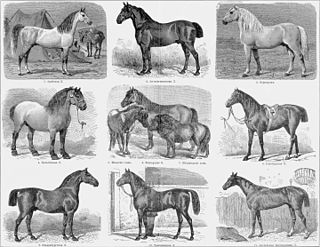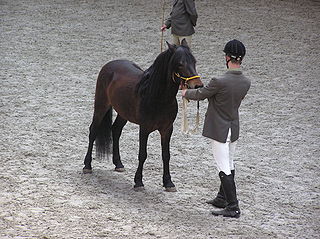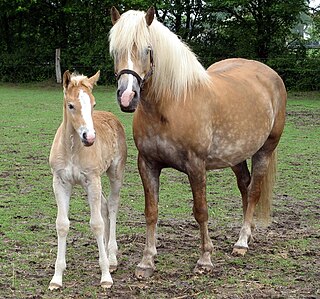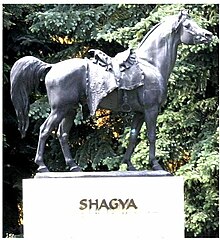
A horse breed is a selectively bred population of domesticated horses, often with pedigrees recorded in a breed registry. However, the term is sometimes used in a broader sense to define landrace animals of a common phenotype located within a limited geographic region, or even feral "breeds" that are naturally selected. Depending on definition, hundreds of "breeds" exist today, developed for many different uses. Horse breeds are loosely divided into three categories based on general temperament: spirited "hot bloods" with speed and endurance; "cold bloods," such as draft horses and some ponies, suitable for slow, heavy work; and "warmbloods," developed from crosses between hot bloods and cold bloods, often focusing on creating breeds for specific riding purposes, particularly in Europe.

The Arabian or Arab horse is a breed of horse with historic roots on the Arabian Peninsula. With a distinctive head shape and high tail carriage, the Arabian is one of the most easily recognizable horse breeds in the world. It is also one of the oldest modern breeds. Although modern DNA cannot trace breed purity in the modern population beyond 200 years, there is archaeological evidence of horses in the Middle East with landrace characteristics that resemble modern Arabians dating back 3,500 years. Throughout history, Arabian horses have spread around the world by both war and trade, used to improve other breeds by adding speed, refinement, endurance, and strong bone. Today, Arabian bloodlines are found in almost every modern breed of riding horse.
Purebreds are like cultivars of an animal species achieved through the process of selective breeding. When the lineage of a purebred animal is recorded, that animal is said to be pedigreed. Purebreds breed true-to-type which means the progeny of like-to-like purebred parents will carry the same phenotype, or observable characteristics of the parents. A group of like purebreds is called a pure-breeding line or strain.
A crossbreed is an organism with purebred parents of two different breeds, varieties, or populations. Crossbreeding, sometimes called "designer crossbreeding", is the process of breeding such an organism. While crossbreeding is used to maintain health and viability of organisms, irresponsible crossbreeding can also produce organisms of inferior quality or dilute a purebred gene pool to the point of extinction of a given breed of organism.

The Hucul or Carpathian is a pony or small horse breed originally from the Carpathian Mountains. It has a heavy build and possesses great endurance and hardiness. The breed is also referred to as the Carpathian pony, Huculska, Hutsul, Huțul, Huțan or Huzul. The breed gets its name from the Hutsul people, who live mostly in the Carpathians in Ukraine and in Romania, but also in an area in the East Carpathian Mountains north of the river Bistritz, officially named “Huzelei”.

The Haflinger, also known as the Avelignese, is a breed of horse developed in Austria and northern Italy during the late 19th century. Haflinger horses are relatively small, are always chestnut with flaxen mane and tail, have distinctive gaits described as energetic but smooth, and are well-muscled yet elegant. The breed traces its ancestry to the Middle Ages; several theories for its origin exist. Haflingers, developed for use in mountainous terrain, are known for their hardiness. Their current conformation and appearance are the result of infusions of bloodlines from Arabian and various European breeds into the original native Tyrolean ponies. The foundation sire, 249 Folie, was born in 1874; by 1904, the first breeders' cooperative was formed. All Haflingers can trace their lineage back to Folie through one of seven bloodlines. World Wars I and II, as well as the Great Depression, had a detrimental effect on the breed, and lower-quality animals were used at times to save the breed from extinction. During World War II, breeders focused on horses that were shorter and more draft-like, favored by the military for use as packhorses. The emphasis after the war shifted toward animals of increased refinement and height.

The Crabbet Arabian Stud, also known as the Crabbet Park Stud, was an English horse breeding farm that ran from 1878 to 1972. Its founder owners, husband and wife team Wilfrid Scawen Blunt and Lady Anne Blunt, decided while travelling in the Middle East to import some of the best Arabian horses to England and breed them there. They maintained the Sheykh Obeyd estate near Cairo to facilitate this. Their daughter Judith Blunt-Lytton, 16th Baroness Wentworth carried on the stud until her death. The stud was sold up in 1971, but its bloodlines continue to influence the breed worldwide in the 21st century.

A stud farm or stud in animal husbandry is an establishment for selective breeding of livestock. The word "stud" comes from the Old English stod meaning "herd of horses, place where horses are kept for breeding". Historically, documentation of the breedings that occur on a stud farm leads to the development of a stud book. Male animals made available for breeding to outside female animals are said to be "standing at stud", or at "stud service", referencing the relatively high probability that they are kept at a stud farm.
"Al Khamsa" (الخمسة) is a designation applied to specific desert-bred bloodlines of the Arabian horse considered particularly "pure" by Arabian horse breeders, who sometimes also describe such lines with by use of the Arabic word asil, meaning "pure". It also refers to a mythical origin story of the breed

Skowronek was an Arabian stallion foaled in 1908 or 1909. He was bred by Count Józef Potocki who owned the Antoniny Stud in Poland. He was imported to England as a young horse. Upon purchase by Lady Wentworth, Skowronek became a foundation stallion at Lady Wentworth's Crabbet Arabian Stud. He was most often crossed on mares who were daughters or granddaughters of the stallion Mesaoud, another foundation stallion for Crabbet, who had been bred by Ali Pasha Sherif and imported from Egypt to England by Lady Wentworth's parents, Wilfrid and Lady Anne Blunt.
Henry B. Babson was an American entrepreneur, investor in phonograph technology, and notable breeder of Arabian horses. He moved to Chicago at the age of 17 at the urging of inventor Leon Douglass. While working at the 1893 World's Columbian Exposition, better known as the Chicago World Fair, Babson first encountered purebred Arabian horses brought from the Middle East for exhibition, and decided that some day he would own such horses for himself.
An Austrian Warmblood is a warmblood type of horse registered with the Arbeitsgemeinschaft für Warmblutzucht in Österreich. Although the studbook is made up of jumping and dressage horses from many other countries, the mare base consists of native horses with a long history. The AWÖ keeps an open studbook, in which mares and stallions must pass rigorous inspections before becoming breeding stock.
Al Khamsa is a nonprofit organization in the United States that supports the preservation breeding of certain strains of purebred Arabian horses, specifically lines tracing exclusively to those pedigrees providing a detailed chain of evidence to prove they were bred by the Bedouin of the Arabian peninsula. The name derives from the Al Khamsa Arabian mares, the name applied to the legendary five favorite horses of Mohammed. The particular purpose of Al Khamsa is to "preserve the original Bedouin Arabian horse in pure bloodlines in North America."
Foundation stock or foundation bloodstock refers to animals that are the progenitors, or foundation, of a breed or of a given bloodline within such. Many modern breeds can be traced to specific, named foundation animals, but a group of animals may be referred to collectively as foundation bloodstock when one distinct population provides part of the underlying genetic base for a new distinct population.

The Gidran, Gidrán, or Hungarian Anglo-Arab is a horse breed developed in Hungary from bloodstock that included the Arabian horse. All members of the breed are Chestnut. It is an endangered breed today, with only about 200 living representatives worldwide.
The Purosangue Orientale or Puro Sangue Orientale (PSO), is a horse breed developed in the Kingdom of Italy by Royal Decree n° 2690 of 19 September 1875, which created a stud book dedicated to the breed. Beginning in 1864, the Italian Government had sent emissaries into Syria and Mesopotamia to purchase desert bred Arabian horses directly from Bedouin tribes. Numerous stallions and mares were purchased and brought back to Sicily, many being destined for the Royal Remount Station in Catania. The breeding of Arabian Horses in Italy, therefore predates the Crabbet Park Stud which only started in 1878. Furthermore, the Crabbet Park Stud obtained most of its horses from the stables of Abbas-Pasha in Egypt, and therefore Africa, whereas the horses obtained from the Italian Government came directly from the Syrian Desert, and therefore from Asia and Arabia. One must also consider that the financial resources of a major European government must also surpass those of a private individual and a government can certainly afford to purchase much more expensive horses, since the purpose was to improve cavalry remounts and therefore national interest was at stake. Lastly, the Italian Government could also rely on the expertise of Carlo Guarmani, who was born in Italy in 1828, but whose family moved to the Middle East, where he was raised. He was fluent in Arabic and had a passion for horses, and spent 16 years traveling in Syria, Palestine, Egypt and Northern Arabia. He knew the Bedouins of the Syrian desert well and spent much time with them. He was commissioned to acquire Arab stallions for the stables of Napoleon III and for the then king of Italy, Vittorio Emanuele II. Although he had been to Egypt, he headed for the Syrian desert when he needed to purchase horses. His knowledge and direct contact with the Bedouins of the Arabian desert was far greater than that of Lady Anne Blunt, the founder of Crabbet Park Stud.

A part-Arabian, partbred Arabian or, less precisely, half-Arabian, is a horse with documented amounts of Arabian horse breeding but not a purebred. Because the Arabian is deemed to be a breed of purebred horse dating back many centuries, the modern breed registries recognized by the World Arabian Horse Organization generally have tightly closed stud books which exclude a horse from registration if it is found to contain any outside blood. However, Arabian breeding has also been used for centuries to add useful traits to countless other horse breeds. In the modern era, crossbreeding has been popular to combine the best traits of two different breeds, such as color, size, or ability to specialize in a particular equestrian discipline.

The Yeguada Militar de Jerez de la Frontera, known outside Spain as the Yeguada Militar, is a military Spanish stud farm headquartered in Andalusia, Spain, dedicated to horse breeding of purebred Andalusian horses and Arabian horses. Founded in 1847, it became the state military stud farm in 1893. In the 20th century, as need for cavalry horses declined, the stud's emphasis shifted to become a genetic reservoir to preserve the bloodlines of the Pure Spanish Horse and to continue to breed high quality Arabian horses, with stallions of both breeds being made available to private horse breeders to improve the horses of Spain. Today, there are two facilities located in the Jerez de la Frontera area, one primarily for stallions, the other for mares and foals, as well as multiple stallion depots across the country.

The Polish Arabian is the variety of Arabian horse bred in Poland. Arabian horses were introduced to Poland in the 16th century via prizes of war. It was not until the 19th century that organized pure-bred breeding was established. The Polish Arabian was decimated during the two world wars, leading to the loss of breed registry and the vast majority of the livestock. In 1926, Dr. Edward Skorkowski created a studbook and a dedicated breeding society. Breeding resumed in the 1940s and 1950s, based on a small group of surviving breeding stock.

The Egyptian Arabian is a line of the Arabian horse originating from Egypt. These horses come mainly from the selective breeding program launched by Abbas I Hilmi in 1848, and continued to this day at the El Zahraa stud farm. Although of Egyptian origin, the breed is defined by Euro-American breeders who imported a large number of these animals during the 20th century, then imposed their standards and selection criteria, in particular with the formation of the Pyramid Society in the United States in 1970. The Society's marketing strategy made the Egyptian Arabian a luxury animal, attracting wealthy investors by associating the concept of "purity" in this breed with knowledge of its genealogy.

















